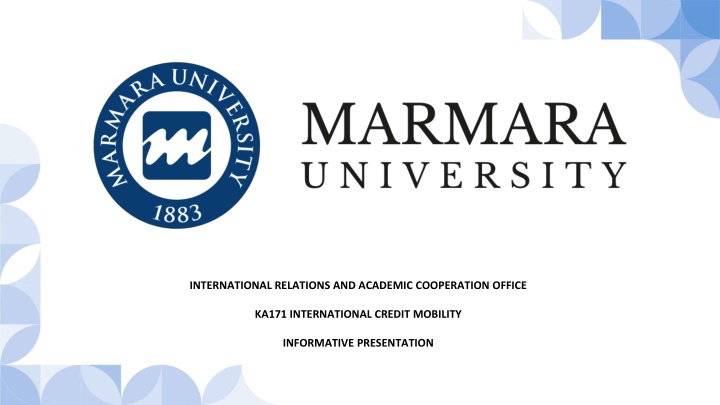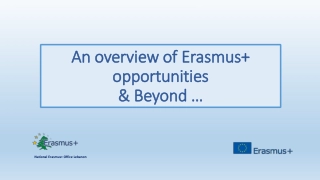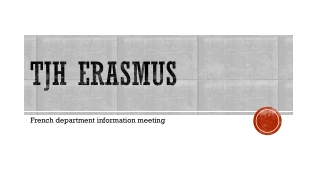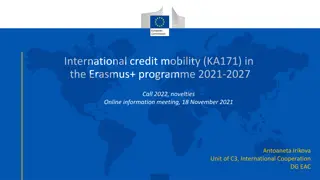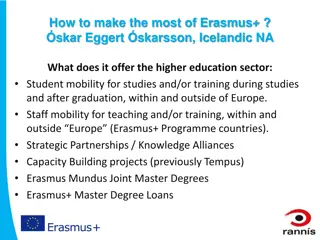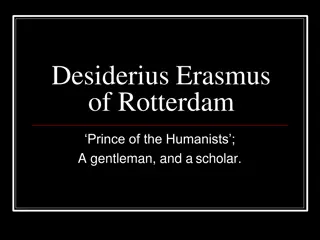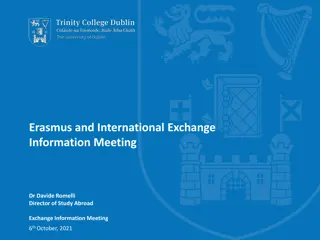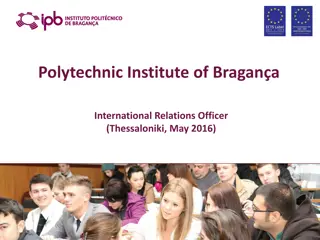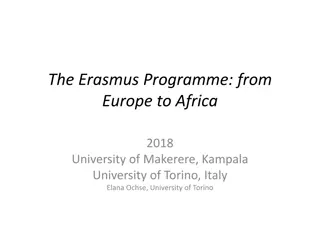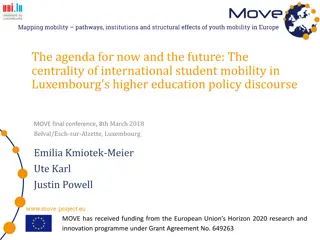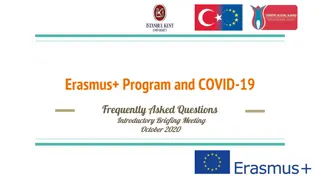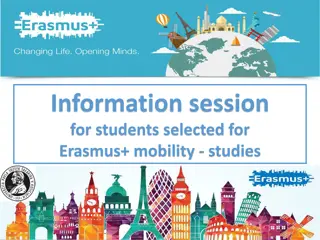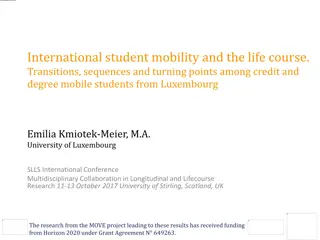ERASMUS KA171 International Credit Mobility Program Overview
Discover the ERASMUS KA171 program offering credit mobility opportunities for students and staff between Programme and Partner Countries. Gain insights into mobility durations, eligible countries, grants, and application process with a focus on student education, internships, and staff teaching/training.
Download Presentation

Please find below an Image/Link to download the presentation.
The content on the website is provided AS IS for your information and personal use only. It may not be sold, licensed, or shared on other websites without obtaining consent from the author.If you encounter any issues during the download, it is possible that the publisher has removed the file from their server.
You are allowed to download the files provided on this website for personal or commercial use, subject to the condition that they are used lawfully. All files are the property of their respective owners.
The content on the website is provided AS IS for your information and personal use only. It may not be sold, licensed, or shared on other websites without obtaining consent from the author.
E N D
Presentation Transcript
INTERNATIONAL RELATIONS AND ACADEMIC COOPERATION OFFICE KA171 INTERNATIONAL CREDIT MOBILITY INFORMATIVE PRESENTATION
What is ERASMUS KA171? Context and opportunity Credit mobility between Programme and Partner Countries Mobility of students and staff (for learning and teaching) Action managed by National Agencies located in Europe Use of Erasmus Quality Framework
Student and Staff Mobility Erasmus-like conditions All levels (Bachelor, Master, PhD) and all disciplines two to twelve months for STUDENT studies two to twelve months for STUDENT internships Up to 12 months per study cycle For STAFF from five days to two months mobility
Mobility Duration: Proje Project ct Term 36 months Term: : Student Student Education Education Mobility 2-12 months Mobility: : Student StudentInternship Internship Mobility 2-12 months Mobility: : Staff Staff Teaching Teaching/Training 5 days 2 months (60 days) except for travel duration /Training Mobility Mobility: :
Programme Countries Programme Programme Countries EU Countries Iceland Liechtenstein North Macedonia Norway Serbia Turkey Partner Partner Countries Countries: : Countries: : All countries except Andorra, Monaco, San Marino, Vatican, Faroe Islands and Switzerland
Grants Grants Grants for for students students: : Incoming (To Turkey): Monthly 800 Outgoing (To Partner): Monthly 700 Grants Grants for for staff staff: : Incoming (To Turkey): Daily 140 Outgoing (To Partner): Daily 180 *Grant for staff is fully paid in first 14 days, between the days 15 60 %70 of the full grant is paid. Travel Grant Travel Grant for for Students Students and and Staff Staff: : It is between 20 - 1.500 depends on the distance between two countries.
How to Apply These four quetions below should be responded Project Design and Quality of the cooperation arrangements (Once for each region) Relevance of the strategy (Max 40 points) Impact and dissemination (Max 20 points) Qality Assessment * Total 60 *First Criterion %50
Question1- Relevance of the strategy The extent to which the planned mobility project is relevant to the internationalisation strategy of the higher education institutions involved (both in the Programme and in the Partner country) and the rational for choosing staff and/ or student mobility. Explain why the planned mobility project is relevant to the internationalisation strategy of the higher education institutions involved (both in the Programme and the Partner country. Justify the proposed type(s) of mobility (students for studies /students for traineeships/staff for teaching/staff for training
Relevance of the strategy Things to consider: Why did we choose KA107, this partner country, this partner university and this field? What will be outcome of the mobility, what is our aim? How will the mobility serve internationalisation strategy of your institution or country?
Question2- Project Design and Quality of the cooperation arrangements The extent to which the applicant organisation has previous experience of similar projects with higher institutions/organisations in the partner country and the clarity of the description of responsibilities, roles and tasks between partners. Detail your previous experience of similar projects with higher education institutions in this Partner country, if any, and explain how, for the planned mobility project, responsibilites, roles and tasks will be defined in the Inter-Institutional agreement. If applicable, provide as well the available information on your previous experience and planned cooperation arrangaments with non-academic partners in your country and in this Partner Country.
Question2- Project Design and Quality of the cooperation arrangements The completeness and quality of arrangements for the selection of participants, the support provided to them and the recognition of their mobility period. Services provided for these people (language education, orientation programme etc.) Present the different phases of the mobility project and summarise what partner organisations plan in terms of selection of participants, the support provided to the and the recognition of their mobility period. Is there a former cooperation between two institutions? How will the exchange be operated in both institutions? How will the work be shared in your institution? How will you use your previous experiences on operating this exchange? How will you divide the duties and responsibilities for this exchange? (such as communication channels etc.)
Project Design and Quality of the cooperation arrangements Things to consider: How will the project by both institutions in before during after phases. How will each process be handled (such as notification, selection of exchange students / staff, criteria etc.)
Question 3 - Impact and disseminationoints) The potential impact of the project on participants, beneficiaries, partner organisations, at local, regional and national levels and the quality of measures aimed at disseminating the results of the mobility project at faculty and institution levels, and beyond where applicable, in both the programme and partner countries. Projenin etkilerinin yayg nla t r lmas na y nelik faaliyetler Explain the desired impact of the mobility project on participants, beneficiaries, partner organisations and at local, regional and national levels. Describe the measures which will be taken to disseminate the results of the mobility project at faculty and institution levels, and beyond where applicable, in both the Programme and Partner Countries.
Contact: international@marmara.edu.tr
